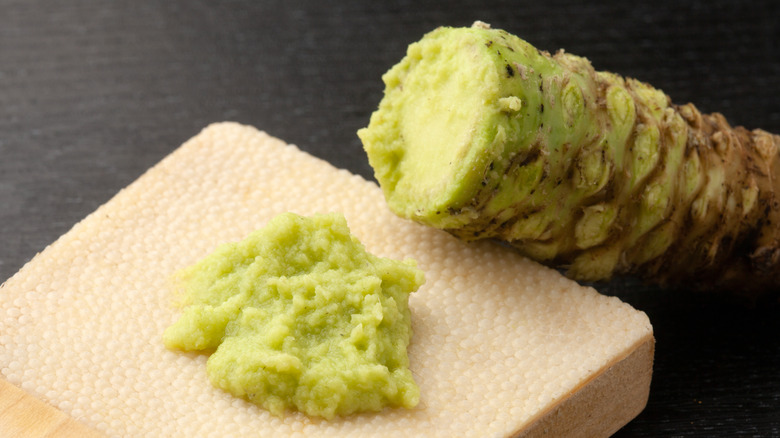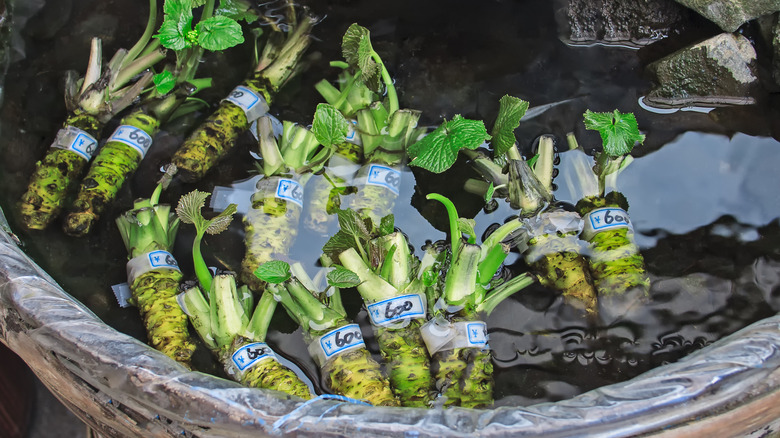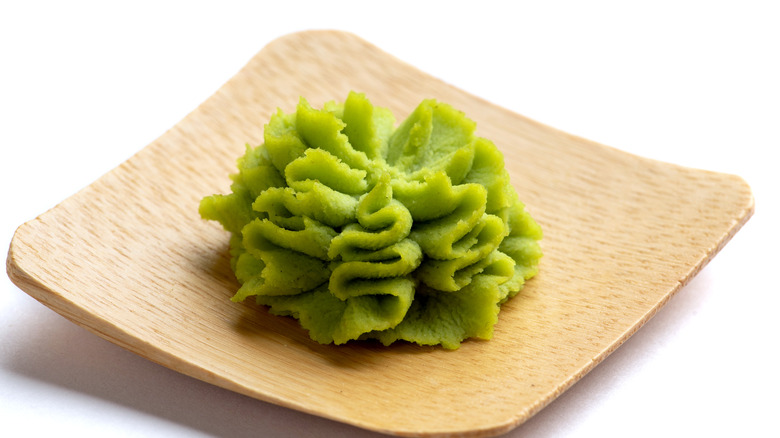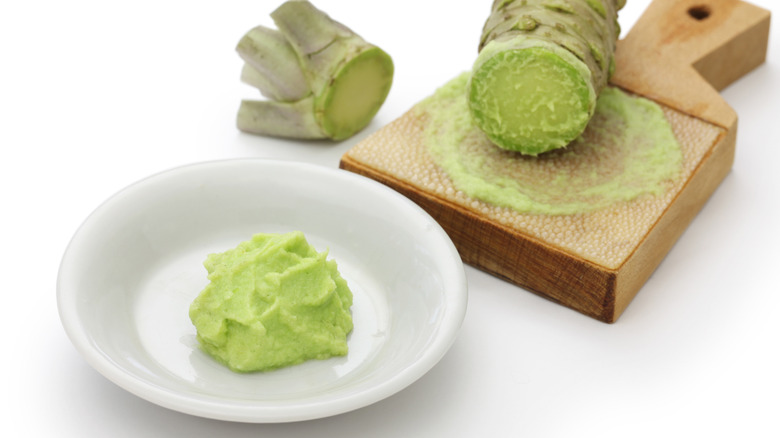Everything You Need To Know About Wasabi
If you're not a fan of Japanese food, you may not know this condiment by name. Still, you're not likely to forget the effect it has on your sinuses after you've had it. Wasabi, or Wasabia japonica, is the green paste that is served to you with your soy sauce and ginger, along with your sushi or sashimi (via MasterClass). And because it comes from a rhizome, this condiment is a cousin to ginger, turmeric, and the lotus (via Britannica).
Wasabi wasn't always used to just add an extra kick to a raw fish dish. The earliest mentions of wasabi in Japanese writings date back centuries, and identified the rhizome as a medicinal plant. This didn't change until the Edo period or the late 1800s, when wasabi began being used as a preservative that kept fish from turning bad and growing bacteria, while it protected the humans who consumed the dish from falling ill with food poisoning at the same time (via Kinjirushi Wasabi).
Wasabi didn't adopt the form that we'd be familiar with until the Taisho period, or the early 20th century, which was when manufacturers began making powdered wasabi by drying and pulverizing it. From there, it wasn't long before manufacturers began making powdered wasabi by using horseradish, and the rest is food history.
How is wasabi grown?
The wasabi plant wants what it wants, and as such is a difficult plant to raise. Under normal circumstances, Britannica says a typical wasabi needs about three years to become fully mature. However, it can also fall ill quite quickly, and its growth can be impeded if leaves are broken by other produce or animals. Because wasabi is difficult to cultivate, it is grown in just a small number of places, including Japan's Shizuoka, Iwatane, and Nagano areas, as well as the Izu Peninsula. Areas that cultivate wasabi are likely to have fields which have been set up to look and feel identical to the wasabi's home grounds. It should have plenty of rocks and gravel, with the ability to tolerate some flooding.
Washington State University Department of Horticulture Professor Carol Miles told the BBC in 2014 that essentially, the wasabi rhizome is "a water loving plant, but it does not grow completely submerged in water like a water lily or something. In general, water flows over the crop, so it's grown in water beds and that's not something we commonly do in North America."
Outside of Japan, a few farmers have tried to grow the plant, but many have failed. One exception is Canadian farmer Brian Oates of Pacific Coast Wasabi, who came up with a method that sees wasabi grown to a commercial scale today.
Different types of wasabi
But if wasabi is so difficult to cultivate, why do we see it everywhere? The simple answer is: We don't, because nearly all of the wasabi we see — Makesushi says that figure is close to 95% — is a copycat of the real thing, made by mixing horseradish, mustard flour, corn starch, and green food coloring (via MasterClass). Real wasabi generally does not come out of a tube, although it can come in powder form. The condiment is grated from the rhizome itself, and with a special grater made with sharkskin before serving. Once grated, real wasabi needs to be consumed immediately or its flavor begins to fade (via Gastro Obscura).
It may be difficult for someone who has never had real wasabi before to figure out the difference between the real condiment and its more common cousin on taste alone. MasterClass describes real wasabi as having an "aromatic and herbaceous" taste that is known for being spicy, but not necessarily hot. And because imitation wasabi packs horseradish, it will also carry the one-two spice-and-heat punch that sushi fans will recognize. The rarity of real wasabi makes serving pretend wasabi a necessity; Real wasabi can cost upwards of $300 a kilo while imitation wasabi costs about $5 per kilo.
How do you consume wasabi?
Whether it is real or imitation, those who enjoy the spiciness/heat that wasabi brings to the flavor equation will enjoy consuming the condiment in more ways than as part of the traditional dipping sauce for sushi and sashimi, or as a pick-me-up to a bowl of Japanese soba or buckwheat noodle dish. Wasabi — particularly its stronger-flavored, more economical version — can be blended to more neutral-to-sweet vinegars for a light, mouthwatering dressing. It can be added to sandwiches in place of mustard for an extra kick. MasterClass suggests wasabi can also even be blended to different soups, stews, and sauces in order to liven up a dish. MasterClass says blending wasabi with ketchup and soy sauce to get an east-west shrimp cocktail dipping sauce will give you a something to wow guests with at your next gathering.
But with the prohibitive cost of real wasabi, it may be best to save authentic wasabi to enjoy with the best sushi meal your budget will allow. Your palate will thank you.



